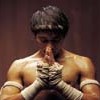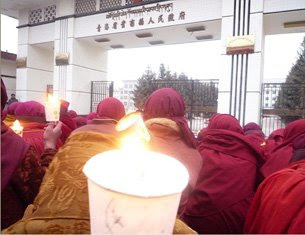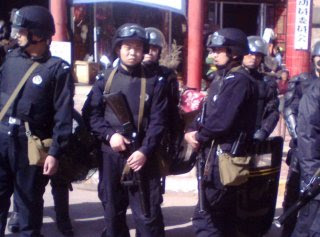Agam's Gecko


Saturday, February 28, 2009
DEFIANCE AND SACRIFICE DURING A NEW YEAR LIKE NO OTHER
| T |
he first noteworthy date of 2009, Losar, has passed in Tibet with very little celebration -- but with a fair measure of defiance and sacrifice. Several large demonstrations of peaceful resistance to China's oppression were shown by Tibetans. Chinese security forces demonstrated how not to save a burning man.
But of course, saving him was never their intention. Perhaps now the world may take notice of their actual intent. The photograph at left is another infuriating example of China's intentions for their Tibetan colony.
Yesterday afternoon at around 1 pm, about 1000 monks at Kirti Monastery (Ngaba County and Prefecture) gathered before the monastery's main prayer hall to observe Monlam Chenmo (the Great Prayer Festival)**, which they traditionally mark on the third day of Losar. Chinese authorities had previously forbidden them from this religious observation, but the monks had gathered in defiance of this order. Finding themselves locked out of the prayer hall, the monks were persuaded by the abbot and members of the Communist Party's monastic watch-dog "Democratic Management Committee" (every monastery has a DMC) to return to their quarters.
At around 1:40 pm, a young monk named Tabey walked out of the monastery toward Ngaba town, holding high a hand-drawn Tibetan national flag with a picture of the Dalai Lama at its centre. When he reached the town, Tabey poured petrol on himself and set himself on fire.
Tsering, a monk from Kirti Jheypa monastery in Dharamsala told Voice of Tibet radio that bystanders saw Tabey shot by security forces.
According to Tsering, bystanders saw him collapse on the ground after they heard three gunshots. The monk was reportedly taken in a vehicle to a nearby hospital, said Tsering, but it is not known if he is alive or dead at the time of this report going online.Eyewitness accounts were also received by Free Tibet in London. The sources described Tabey shouting freedom slogans as he walked, holding aloft his country's national symbols.
On arriving in the main town area, Tabe poured petrol over himself and set himself alight. According to sources he was immediately surrounded by several armed Chinese police. The eyewitnesses reported seeing the armed police pointing guns at Tabe after he had set himself alight and then heard three separate gun shots. The monk immediately fell to the ground. According to the eyewitnesses the police extinguished the flames almost immediately after Tabe had collapsed to the ground and then transferred Tabe’s body to a nearby van which drove away to an unknown location.If these reports are accurate -- and there are enough witness accounts from different sources that I think they can be accepted as confirmed -- then the occupying power in Tibet has set its place in history with another first. Never before, to my knowledge, has a self-immolator ever been extinguished by shooting him first.
Was such an order given? Did some Chinese captain give the order to "put out that monk!" and his squad took him literally? Did he give the order to kill? We may find out, if further information is able to escape the area. Kirti was the scene of one of the earliest massacres of Tibetans last year, after security forces opened fire on a large group of peaceful protesters on March 16, killing about two dozen people.
"First, China should understand the aspirations and thoughts of the younger Tibetan generation. Second, China should understand that this year’s boycott by Tibetans of Losar celebrations could be more widespread than last year’s protests.The vigil continued for around 30 minutes and then dispersed peacefully, similar to the only such demonstration reported from Lutsang last year, on March 10. On that occasion, several hundred monks and laypeople protested with freedom slogans and dispersed without arrest, reportedly due to the lack of readily available public insecurity forces.
"Third, the monks have offered their protest and a candlelight vigil as a gift to all Tibetans everywhere," he said. "And fourth, they pray for the wishes of Tibetans to be fulfilled."
Lutsang Monastery, properly known as Nye Gön Shedrub Dargyey Gempel Ling was founded in 1889 by the Fourth Nye Incarnate, Lobzang Chökyi Nyima (1850-1909). After the Cultural Revolution the monastery was revived in 1981, during a brief period of religious tolerance by Chinese authorities.
Elsewhere in Tibet, the beginning of Losar passed quietly (other than the televised extravaganza broadcast on state television, shamefully hosted by a Canadian comedian). A Lhasa resident, calling on a listener hotline run by RFA's Tibetan service, said the Barkhor was packed with soldiers -- making for a frightening experience just to walk about in the city. Foreigners are banned, but even the recent presence of selected journalists on a contrived "tour" hadn't mitigated the arbitrary treatment Tibetans receive.
"I saw with my own eyes, on Feb. 10 at 7 p.m., five students arrested by soldiers for no particular reason. People are being detained randomly. The students were 20-somethings, male. An army vehicle stopped by, and they were thrown straight into the vehicle.
"Everyone who saw it said that was outright injustice. I think it was on the same day when a state media tour was being conducted for journalists from 10 countries.
"Usually, the government media will blast propaganda about how normal and peaceful Lhasa is. But right now, the officers and the authorities are showing very strong contempt for Tibetans. They’re not bothering to hide it."
"The Tibetan Buddhist monasteries in the Kardze area were offered several thousand yuan for the celebration of Tibetan Losar," the second resident said.Prior to the beginning of Losar, an anchor at China's state television was quoted proclaiming, "The atmosphere welcoming the New Year is deepening. Everyone is praising their happy lives." However, a witness in Lhasa was able to clarify the actual mood. "Compared to last year this time, there are very few people to be seen in Lhasa. No one in and around Lhasa is celebrating Losar."
"There are more than 30 large and small nunneries and monasteries in Kardze area. None of them accepted the government's offer. The monasteries said they were self-supporting and had no need of help for Losar celebrations."
It likely wouldn't be an exaggeration to say that a Losar like this one has never been experienced on the plateau. This is an ancient Tibetan tradition, after all. Yet according to Liu Yunshan, head of the Communist Party's propaganda department, it is "undeniable" that Chinese policies in Tibet "have created one miracle after another." Those propaganda guys always give the best quotes.
** - Monlam Chenmo is apparently observed at different times in different places. At Labrang it was due to take place February 13 - 16, and was strictly prohibited. In an earlier post I quoted an email message from there, in which the writer said that every local government in Amdo was telling its people, "If you will go to Labrang monastery on the 13th 14th 15th and 16th then we don't take care about for your life." This was an open threat, which have been coming more frequently of late. Some recent photos of Chinese security measures in Labrang, apparently taken secretly, may be viewed here (also some recent photos of Lhasa).
On January 15, a 27-year old monk at Kirti Monastery, Lobsang Kirti, was arrested at a copy shop under suspicion of producing leaflets objecting to the authorities' order to observe Monlam Chenmo ahead of the traditional schedule. It appears that the resistance to this order continued until roughly 1000 Kirti monks attempted to properly conduct the ceremony yesterday, when they were locked out of their hall. This is what led to the monk Tabey's defiant sacrifice recounted above.
And on January 27, Chinese police reportedly opened fire on a group of protesting monks at Derge Gonchen Monastery (western Kardze Prefecture) after Chinese government staff partied on the monastery campus (with women dancing around in monks' robes) over the Chinese New Year. The incident occurred at a facility normally used for performance of the ritual "Cham" dances, which are a usual part of Monlam Chenmo.
Readers who wish to see what Monlam Chenmo and the Cham dance rituals are like, should take a look at this fine set of images taken at several locations early this month. Monlam Chenmo rituals are shown taking place at Gomar Monastery in Rebkong, eastern Amdo. I suspect this must have been a government-approved performance (three weeks prior to Losar), as the photos come from Reuters, AFP, AP and Kyodo News (also a few freelance pics from Derge, Lithang and Kardze). Journalists from Reuters and McClatchy have been sending reports from Rebkong recently, so this seems to be considered as a showcase area for China's "one miracle after another."
.











 Our way of saying "thanks" in the Thai way. Here a nak muay Thai (kickboxer) offers respect and thanks for his teacher (wai khru) before a match. This is our local variation on the ubiquitous "hat tip" used in general blog culture.
Our way of saying "thanks" in the Thai way. Here a nak muay Thai (kickboxer) offers respect and thanks for his teacher (wai khru) before a match. This is our local variation on the ubiquitous "hat tip" used in general blog culture.









